Best puppy teething toys 2025 to help alleviate teething pains
The best teething toys for puppies will take a bite out of the pain and distract your pet’s attention away from your shoes
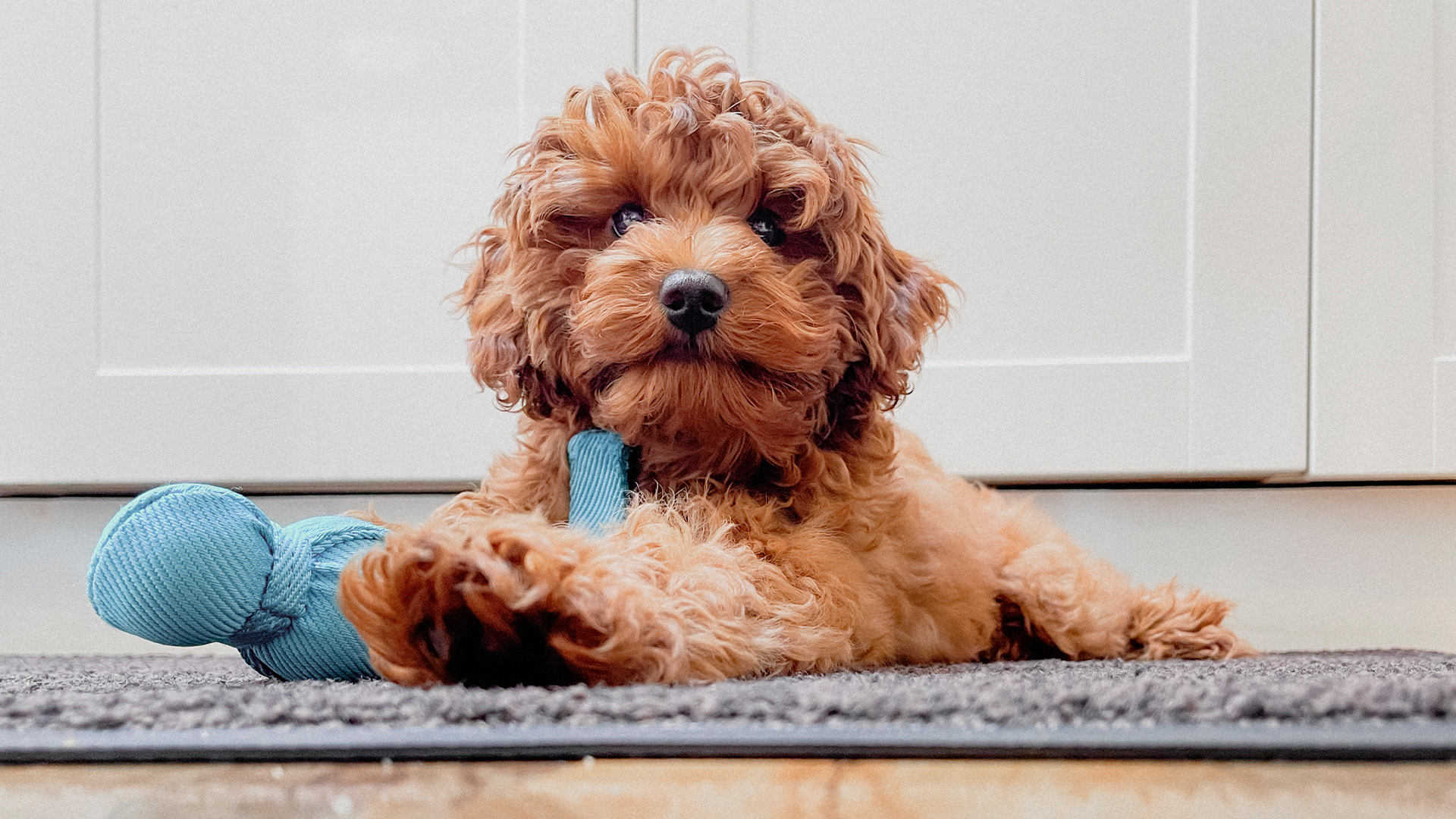
Finding the best puppy teething toys has two benefits: you’ll find you have a much happier and more content pet on your hands, plus you also distract attention away from your furniture and clothes. After all, a teething puppy needs to find an outlet to relieve pain and discomfort during this natural part of growing up and it’s better to provide something safe, appealing and robust.
In this guide, we take a look at some of the best teething toys for puppies including toys that have a delicious flavor and those that can contain treats. We flag up products that can mentally stimulate puppies and toys that will also maintain good dental hygiene. As such, you should easily find something suitable here but it’s important that you consider more than one.
“Make sure you are providing your puppy with plenty of chew toys,” advises expert vet Dr Rebecca MacMillan. “Give him a variety of textures. Some pups like something firm to bite down on, and others want something softer or more textured.”
The best puppy teething toys 2025
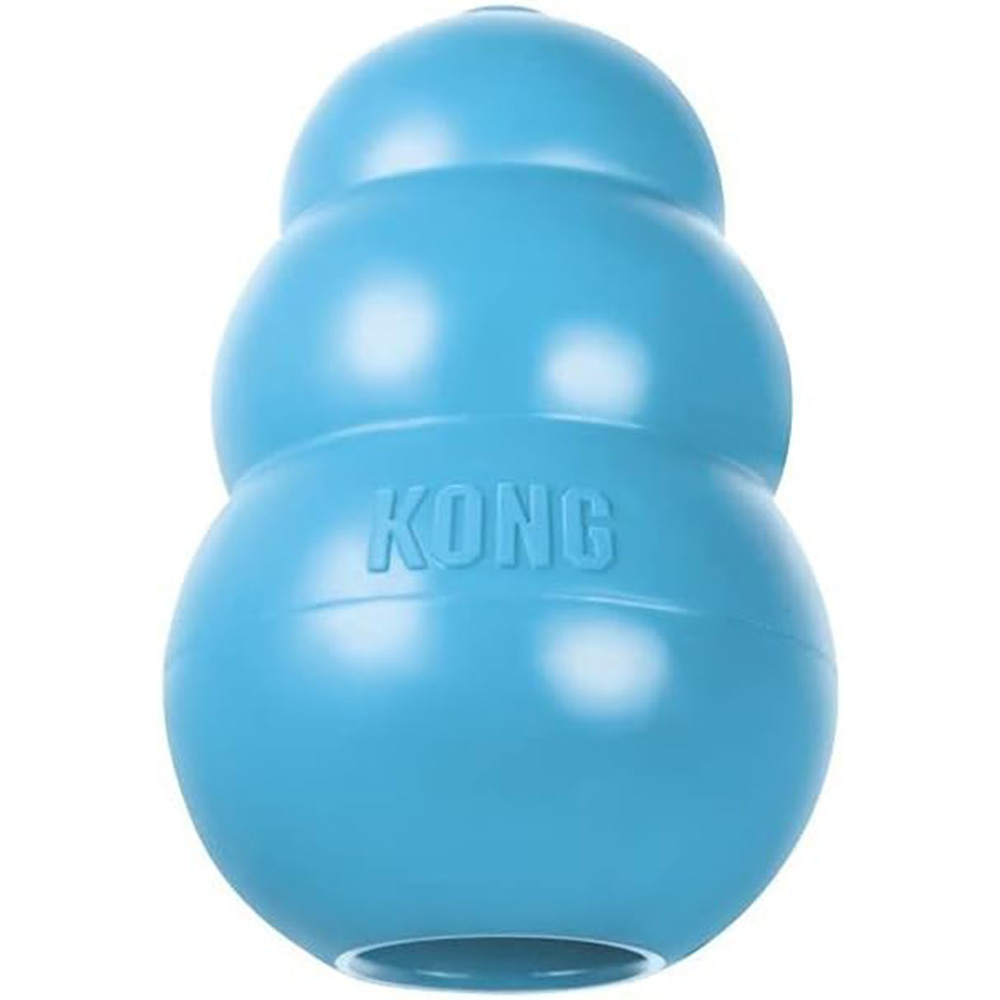
Best overall puppy teething toy
Available in one of four sizes (XS–L) this robust teething toy is a good fit for pretty much any breed of dog. It’s made from a soft rubber formula that is specially customized for a growing pup's baby teeth and gums and, because it has a satisfying bounce, it’s perfect for a game of fetch.
To that end, this puppy teether is ideal for distracting young dogs from chewing more valuable items throughout your home. It’ll also prove mentally stimulating by potentially keeping them entertained for hours. Since the toy is hollow, it can be stuffed with the best dry dog food or gooey homemade dog treats. They’ll be able to dig out the contents to their heart's delight.
With durable rubber that will withstand even the roughest canine teeth and a soft exterior that will soothe those aching teeth, this is a product certainly worth considering. The main problem is that filling the product with food is likely to be smelly and messy so if that sounds gross, maybe look elsewhere.
Reasons to buy: This durable multi-functional toy from a trusted brand is made from soft but tough material.
Reasons to avoid: Although it’s sure to prove mega appealing, stuffing it with food can be messy and smelly.
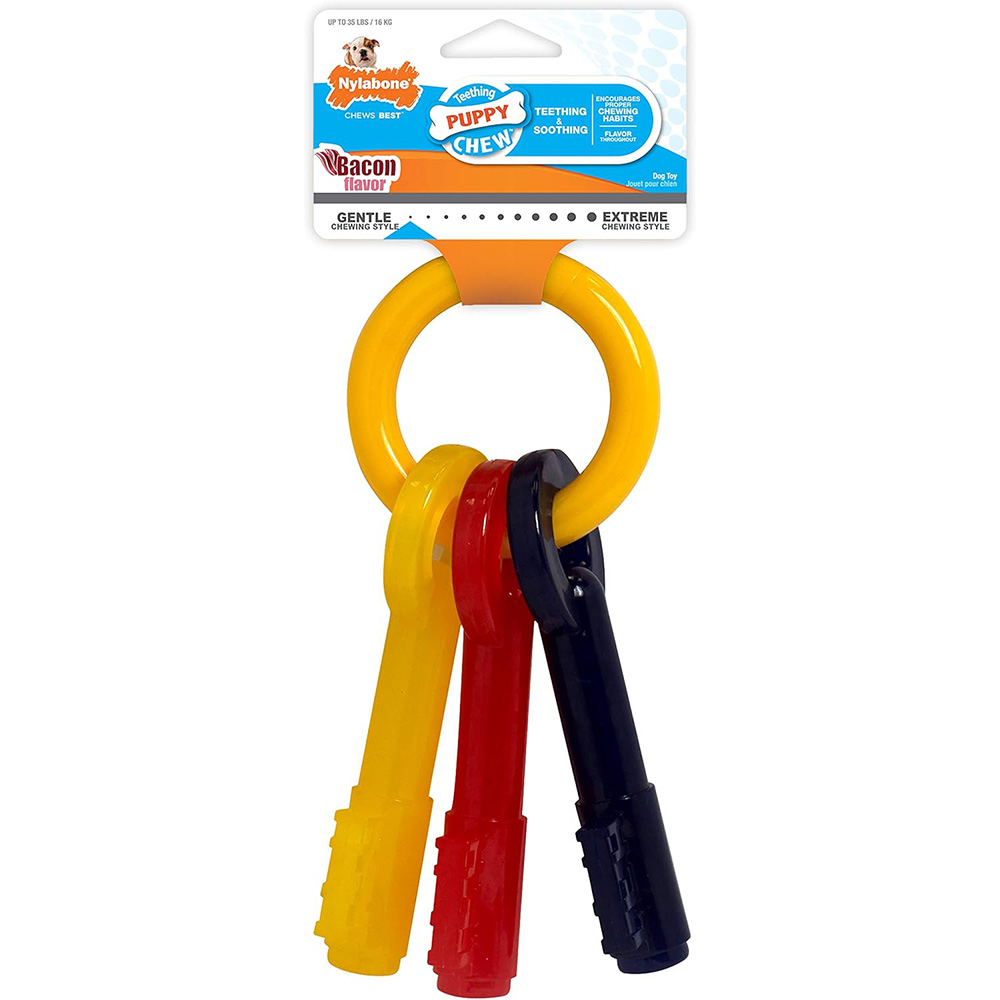
Best dental teething toy for puppies
As well as easing the pain associated with teething, the best teething toys can keep a dog’s teeth in tip-top shape. With this lightweight teething toy that looks like a set of keys, you’re not only getting a soft product that is easy for a dog to get its mouth around, you’re also helping to prevent and reduce the buildup of plaque and tartar thanks to a texture that includes bristles.
The colourful nature of the teething toy combined with the long, bendable shapes is sure to prove attractive to dogs, making it more likely they’ll have a chew. If that doesn’t turn their heads, then they’ll likely be attracted by the bacon flavor instead – let dogs try a taste and they’re sure to want to come back for more.
The good news is that it should withstand some vigorous biting and chewing because it’s built for a canine's grip. It’s made from thermoplastic polymer, so its solid and durable enough for the most part to withstand even a mini teething monster's jaws. That said, it’s always a good idea to supervise use of any teething toy just in case pieces come off.
Reasons to buy: This solidly built, fun product has a delicious, inviting bacon flavor.
Reasons to avoid: Some pet parents say it could be more durable but supervision is key.
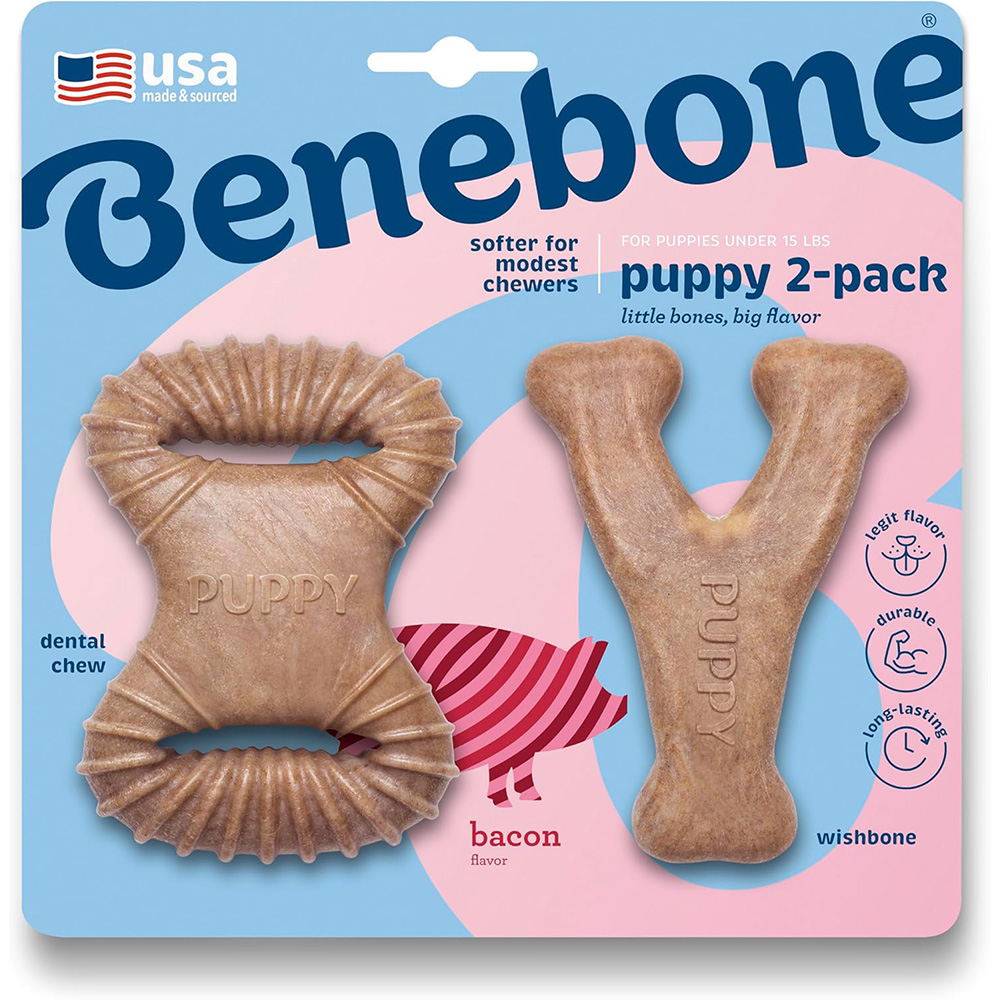
Best hard-wearing teething toy for puppies
Having a variety of teething toys will make it more likely your puppy will turn their attention away from your furniture. With this pack, you get two toys. One is a wishbone shape and the other has ridges to help maintain good dental health.
Both of them are made from the same long-lasting material and they have one other thing in common: they are naturally flavored using 100% real bacon. So if you are looking for a product that isn’t made from the inner layer of an animal’s skin (rawhide) then you’re getting something far more appealing with this one.
We like that the curves of both toys will make it easier for your dog to grab a hold of so that it doesn’t keep slipping away when they chew. We also like that the family-owned company behind the product also has pedigree. Based in the US, it’s been going for more than 10 years and it appears to successfully approach all of it’s chews from a smell-first perspective.
Reasons to buy: Puppies are sure to sniff out this real bacon-flavoured chew that doesn’t give a strong odor for humans.
Reasons to avoid: A good number of pet owners say these chews were harder than they expected as the description says they’re softer.
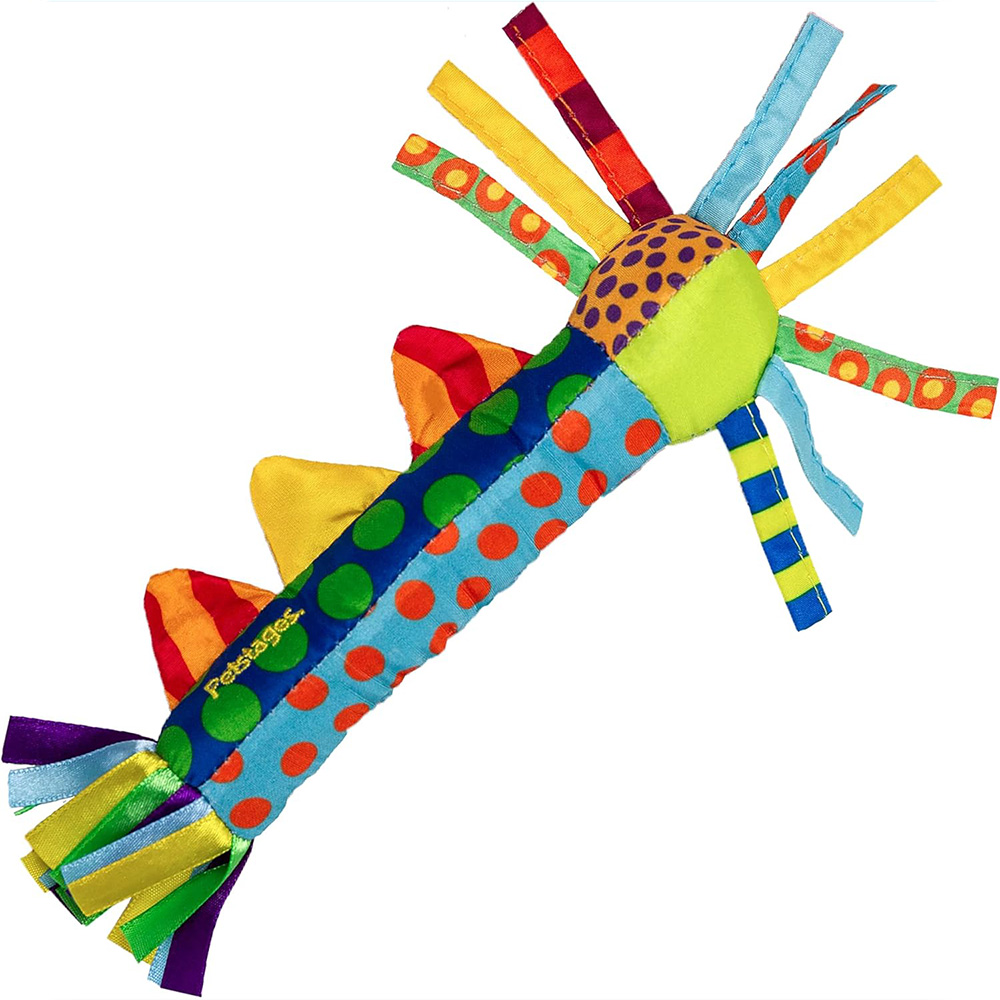
Best freezable teething toy for puppies
Teething aims to relieve pain and discomfort and one way of aiding that is to ensure what they’re chewing is cold. Cold items numb gums and reduce inflammation and that’s where this teething toy comes into its own. The toy itself is wrapped within a brightly-colored cotton casing and this means you can dip it into water and place it in the freezer before handing it to your puppy.
As they chew, they’ll feel the benefit of gnawing on a hard, cold surface and, since the toy is textured with a crunchy feel and a number of streamers and ribbons, it is also sure to be doubly distracting.
As such, it’s a good teething toy to have around but you may need another one to hand for practical reasons. After all, the toy is sure to thaw in a short space of time so it’ll need to be re-prepared over and over again. That does mean extra effort on your part and the requirement to have something else around when this toy is in the freezer.
Reasons to buy: It’s hugely effective in soothing gums since it provides much cold relief.
Reasons to avoid: You’re going to have to keep popping it into the freezer which is a faff.
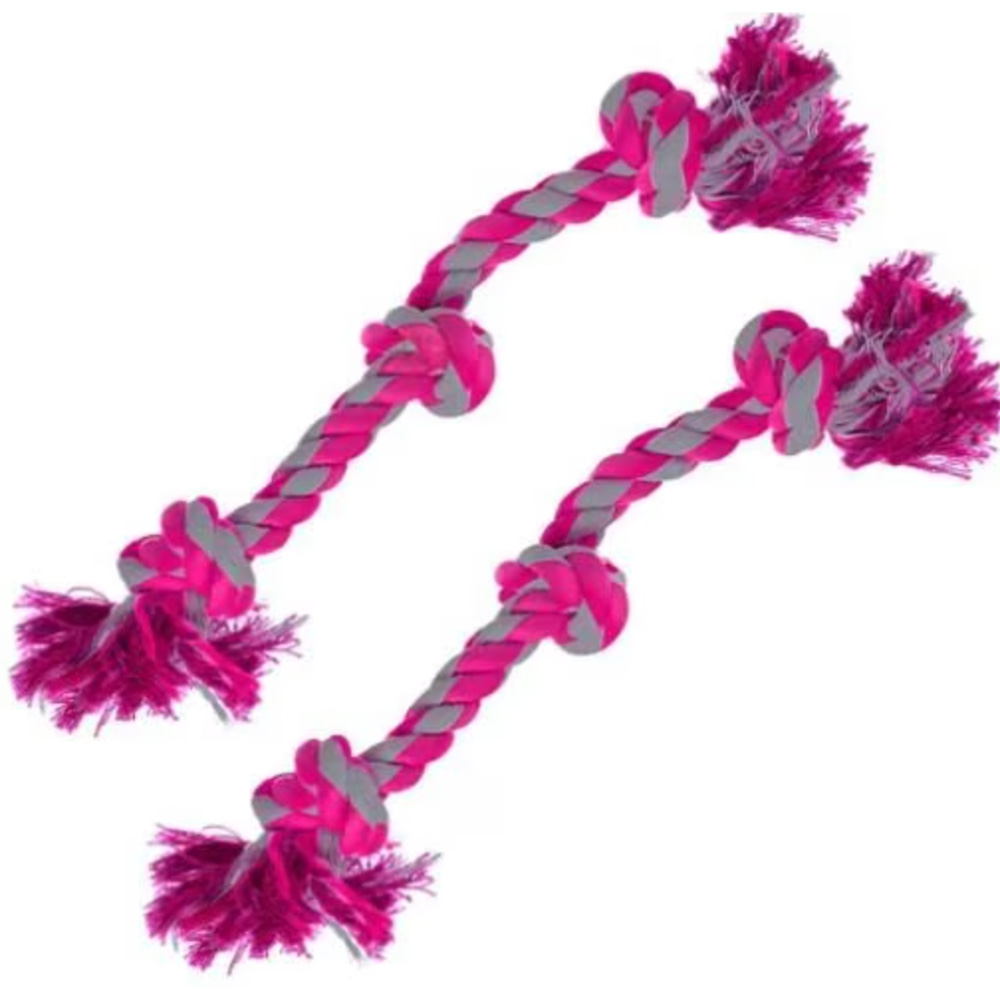
Best tug-of-war puppy teething toy
There’s no reason why you need to leave puppies to their own devices when they are teething. Indeed, you can truly distract their attention away from the discomfort by engaging in some play with them and this rope toy works perfectly. Let your puppy get a hold of one end of the lightweight rope and they can chew, with the texture also helping to remove plaque and tartar. As you pull on the other end, you turn the entire activity into a game. What’s more, since it’s made from cotton, it’s safe, which is always an important consideration.
The colorful nature of the toy makes it easy to find and the size means it’ll be suitable for all small to medium breeds of puppies. It’s perhaps less suited for larger puppies even though it’s aimed at aggressive chewers. There are photos online of the rope toy in shreds but if your puppy is chewing more gently, then it’s sure to last for a good while.
Reasons to buy: It’s a teething toy which will also let you have some fun with your puppy.
Reasons to avoid: It’s not really suitable for larger dogs and aggressive chewers.
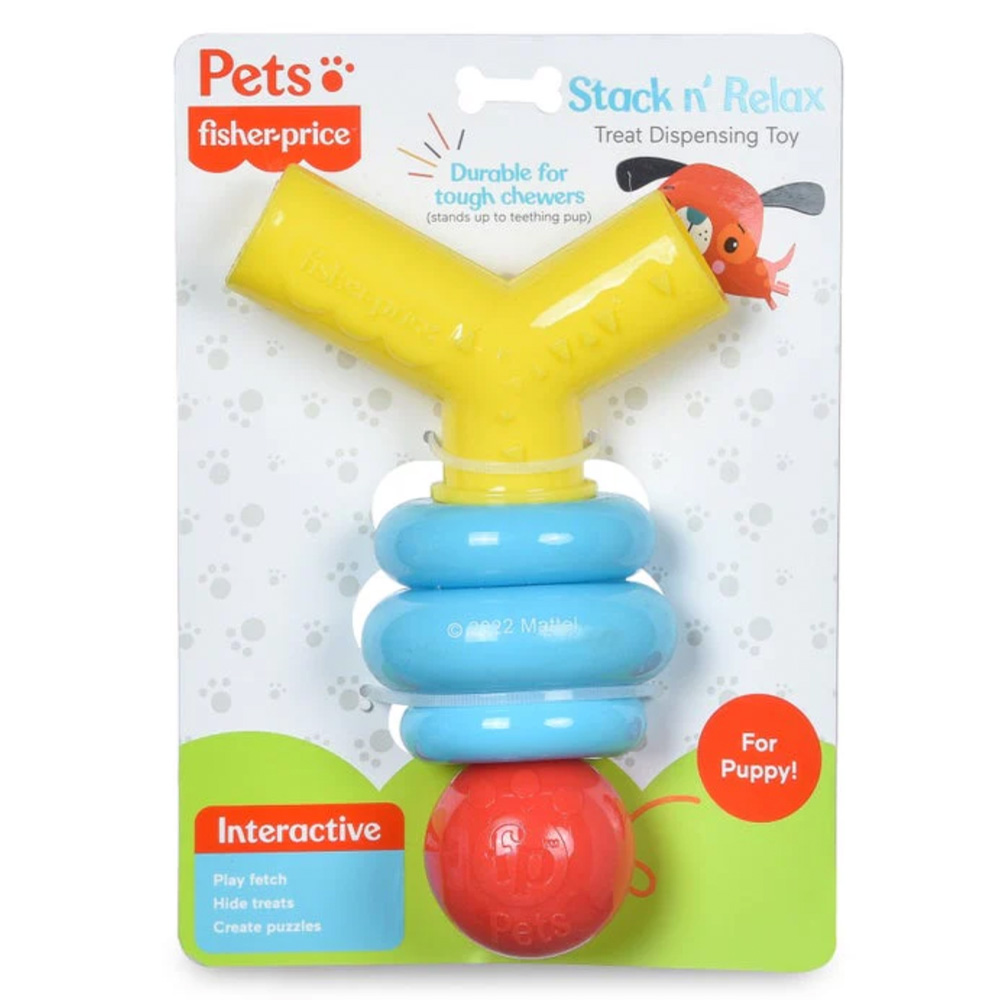
Best puzzle teething toy for puppies
You probably wouldn’t associate Fisher-Price with teething toys for puppies. The near-100-year-old company was established to create educational toys for children and it’s very likely you played with one as a kid. But the company has taken its expertise and experience and created a range of toys suitable for teething pups and this one is a great example.
It’ll withstand the chews of a teething pup while proving to be mentally stimulating. You can use the toy to play fetch and you can pack it with some tasty treats to make it more appealing. The colorful nature of the product will attract attention and you can also use it to create some puzzles. What’s not to love?
This is a toy that you’ll be able to keep beyond the teething stage because it’s just so nice. The tough rubber should stand up to less aggressive chewing and you can be creative in configuring the toy during play. You can also keep it nice and clean with a simple hand wash and rinse. Just be aware that aggressive chewers may well chomp through the yellow tube.
Reasons to buy: It’s a flexible teething toy from a top-brand manufacturer that should prove fun.
Reasons to avoid: Aggressive chewers may show the yellow tube isn’t as robust as you’d like it to be.
How we chose the best puppy teething toys
The best puppy teething toys are specifically designed to be chewed and gnawed on by your teething puppy so our primary concern was safety and resilience. To that end, we looked at the materials being used – we found they were typically made from rubber – and examined whether or not they would stand up to your young canine’s fearsome bite. It’s important that a toy offers enough give to avoid hurting them or damaging their new teeth.
Why are puppy teething toys important?
When you find a puppy teething you’ll notice their behavior changes. They may bite more, become more aggressive, eat more slowly or cry more often. They may also start to chew on your furniture. A teething toy provides a safe outlet for a puppy’s discomfort at this time, in much the same way that the best dog chew toys will prove to be a welcome distraction.
Different teething toys for puppies relieve the problem in different ways. A chew toy will simply allow a puppy to enjoy something firm to bite on while a frozen toy will soothe gums.
What age do puppies need teething toys?
Teething starts at different times depending on the breed but puppies usually get their baby teeth through in the first four to six weeks. They typically start losing their baby teeth a few months later.
"Puppies start to lose their deciduous (milk) teeth at around four to five months of age," explains Dr Rebecca MacMillan. "The process usually starts with the small incisors at the front of the mouth, with the larger teeth following later on."
Different teething toys for different stages?
At eight to 12 weeks, you’ll be looking for products which massage a puppy’s gums or those that can be filled with soothing frozen treats. When they are reaching the end of the teething period introduce the best chew toys for dogs including rope toys, fetch toys and more hard-wearing ones.
“By six months of age or older your dog will have lost all of his deciduous teeth and will have all 42 permanent ones,” says Dr MacMillan. Here’s some more info about how long puppy teething lasts.
Teething toys to avoid
You should avoid natural chew toys, such as bones, antlers and hooves, as these can be too hard on your young pup's mouth or even too large for them in the first instance. Always look for a product that's been professionally devised to help with your puppy's teething phase.
Can puppy teething toys damage teeth?
Where tiny teeth are involved, it goes without saying that you'll want teething toys that are highly durable so that smaller parts don't come off and pose a hazard to your pup. But it’s also important to look for high quality, tough rubber that's firm enough to stand up to chewing but that's soft enough for developing teeth. You'll find many puppy teething products use softer material than their adult counterpart for this reason.
If you’re in the midst of teething, check out these puppy teething tips to help you out, plus we’ve got more advice on how to stop a puppy chewing, too.

Dr. Rebecca MacMillan is a companion animal vet with over 13 years of experience treating and looking after pets. She graduated from the UK Royal Veterinary college in 2009, and has worked in several practices over the years. Rebecca is also an experienced writer, using her veterinary background to offer expert opinion and advice.
Get the best advice, tips and top tech for your beloved Pets

David Crookes has been a journalist for almost 30 years and he has written for a host of magazines, newspapers, websites and books including the World of Animals Annual, BBC Earth, Live Science, The Independent and Tom’s Guide.
Born in England, he lives with two cats but he’s also keenly interested in the differences between the huge number of dog breeds – in fact, you can read many of his breed guides that he’s written in collaboration with vets here on PetsRadar.
With a lifelong passion for technology, too, he’s always on the lookout for useful devices that will allow people to keep their pets happier and healthier, and provide them more time to spend together.
David has a degree from Durham University, as well as postgraduate diploma in journalism from the University of Central Lancashire.
- Dr. Rebecca MacMillanVet
- Ashleigh GibbsDigital Editor
